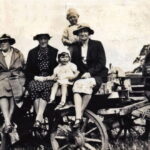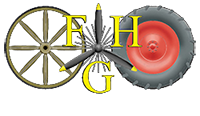The following timeline has been compiled to provide roughly 100-year snapshots from 1640 through to the present day. Information taken from the 1640 Parish Records marks the start date for the timeline. The details below are intended as a set of key facts but more detailed information on each 100-year period can be explored in separate documents.
Timeline: how Fradley has evolved
1640 to the present day
Population:
1640
- Parish records from the 1600s suggest that there were around 50 families living in Fradley with an estimated population of 150-250 people.
1740
- At the commencement of the 19th century (1801 Census) the population was little changed at 268 people.
1840
- The 1841 Census recorded a rise in population to 362.
1940
- Almost 100 years later the 1939 census revealed little change with 382 people recorded.
Present Day
- 2001 Census records 1,691 people.
- 2011 Census records 2,818 people.
- As of the 2021 Census, the population of Fradley was approximately 3,617 residents (City Facts) although recent developments and house building has seen the village grow rapidly with the population now approaching 4,000.

Buildings:
1640
- In 1640 the most prominent building was Old Hall Farm (previously known as Fradley Hall) although this property dates from well before 1640.
- At this time the population would suggest that the village consisted of around 50 buildings although there was no Church or school in the village until the latter part of the 19th
1740
- Fradley Hall remained the most prominent building in the village in 1740.
- The 18th Century saw the village grow with new buildings erected some of which still remain. Fradley Mill was built alongside the Trent and Mersey Canal which opened in 1770.
- The Coventry Canal designed by James Brindley was built between 1768 and 1790 and joined the Trent and Mersey Canal at Fradley Junction in 1789.
- The earliest detailed map of Fradley showing individual buildings is dated 1810.
1840
- It is thought that the number of residences in the village in 1840 had changed little since 1640.
- The 19th Century saw two major developments for the village with St Stephen’s Church built in 1861 and St. Stephen’s School built in 1875.
1940
- There was not a huge amount of growth/development of the village from 1840 through to 1940. It is thought that only about 20 houses may have been built during this time and the village remained very-much farming based.
- The number of households listed in Fradley in the 1939 census was 105.
- With the threat of war construction of RAF Lichfield to the south-west of Fradley on land known as Fradley Heath commenced in 1939 and became operational in 1941. RAF Lichfield was officially closed in 1958 and sold by the Air Ministry in 1962.
- The only ‘community-orientated’ buildings in the village during the 1940s were St. Stephen’s Church, the village Post Office/shop, a mechanics garage and the two main pubs, The Bell Inn and the Bulls Head. Many of the airmen and ground crew serving at Fradley Aerodrome frequented the Bulls Head.
Present Day
- The 1960s saw the start of housing development in the village and later on the former airfield site, with the early 21st Century seeing several major and smaller residential developments taking place.
- As of the 2021 Census Fradley had 1,525 households.
- Since 2021 further development will see the number of households exceed 2,000.
- It seems likely that by 2040 the village will have continued to grow and develop although it is hoped that it will still retain its heritage as a rural settlement.
- A study of Fradley street names completed in 2024 by the Fradley Heritage Group noted that many are named after airmen and ground crew from RAF Lichfield who sadly lost their lives in World War Two, for example Turnbull Road. Other streets are named after long established Fradley family names e.g., Paskin Close, Shaw Close.
Daily life/Occupations:
1640
- In 1640 like much of Britain Fradley was a rural community where incomes relied on the agrarian economy.
- It is presumed the village and surrounding farms were mixed dairy and arable enterprises. Farming at this time was labour intensive and it seems likely that aside from a few farm owners/tenant farmers, many residents of Fradley would have been employed as farm labourers/day labourers or in associated trades such as blacksmiths.
1740
- Throughout the 18th Century Fradley remained a rural farming community with occupations unlikely to have changed significantly from 1640. By the time of the 1801 Census 70 people were employed in agriculture, approximately 26% of the total population of Fradley.
- Parish records from the 1700s reveal some different occupation such as a cordwainer, a butcher, a tailor, carpenter, nailor, blacksmith and a baker.
- This doesn’t tell us a lot about the village, but does suggest at least some pastoral farming, hence the need for a butcher. Having a baker in the village meant that there would have been bread available daily, as well as possibly meat, milk and vegetables. Wells would have provided water, so the village was probably fairly self-sufficient at this time, being perhaps not so reliant on Alrewas.
1840
- By 1840 many of the village farms were dairy, so cows would have regularly been driven along the village roads and tracks. In addition, there would have been horses and carts as well as villagers travelling on foot, and as such it would have been a busy farming scene.
- 1840 would still have seen a lot of ‘agricultural labourers’ (farm workers) living in the village. Walking remained the predominant way that people got around from place to place and this largely meant that people lived close to where they worked and did not travel far or if they did not often.
- Employment in 19th Century Fradley remained heavily reliant on agriculture. Many worked as agricultural labourers, who would not have earned a lot of money and would have had to walk to get anywhere. Children from an early age were often employed typically working on local farms especially at harvest times.
- From the 1841 census, we know some of the professions of the people living in the village at this time. There were two publicans, two tailors, two wheelwrights, two shoemakers, a blacksmith, a butcher, a shop keeper, a school master, a gamekeeper, a book-keeper and two gardeners.
- St Stephen’s School was founded in 1875 shortly after legislation brought in compulsory education in 1870. This enabled Fradley children between the ages of 5 and 13 to attend a local school and to receive formal elementary schooling.
1940
- By 1940 many people in the village still worked on the farms as labourers, waggoners, bricklayers, lorry/tractor drivers and gamekeepers.
- More varied occupations began to appear such railway workers, as crossing gatekeepers, others worked at the local Waterworks as boiler stokers. With the construction of Fradley Aerodrome some were employed as foremen and labourers. There was also a wholesale salesman for a chocolate manufacturer, a tile maker, carpenter, builder/plumber, mechanic, slaughterers, local government workers and school teachers.
Present Day
- The list of professions carried out by villagers has grown exponentially in the post war period. This can be attributed to a large number of reasons; cultural change promoted women working much more and in very diverse sectors, transport became much easier and advances in technology promoted remote working. Even in the 1940s, many jobs were in, or very local to, the village, the main problem being transport.
- In the 21st Century Fradley residents are able to commute long distances to work or using technology work ‘globally’ very easily from home.
People/families:
1640
- Parish records in 1640 show two residents, Henry DANIEL and John SMITH, denoted with the title ‘Mr’, which at the time implied being a ‘gentleman’ and a prominent local person.
- From a document entitled ‘Inventories for residents of Fradley who died 1633-1700’, it shows eight people whose ‘goods and chattels’ were valued at over £100 at the time of their death.
1740
- Parish records from 1740 note a Mr SIMPSON (Old Hall and Lodge Croft), Mr Arthur ONALEY, Mr James ONELY and Mr John BAGGALEY who would all have been prominent figures in the community.
- Other prominent names in the 1740 record were Edward DILKES, Francis COBB and John WRIGHT (Brook Hay)
- Many of the decedents of families from 1640, lived in the village 100 years later.
1840
- By 1840 many of the farms in and around Fradley the farms in Fradley were owned and let out to tenant farmers by the Countess of Lichfield (the Earl’s wife).
- William Shaw was the most prominent and influential person in the village in 1840. He was the tenant of Old Hall Farm, which included three houses at The Sale and huge tracts of land. He also owned Edwards Farm and Marsh Farm at the other end of the village.
1940
- In 1940 William Joseph Shaw was the fourth generation of the Shaw family to live at and farm at Old Hall farm.
- Descendants from the 17th and 18th centuries families were still living in Fradley in 1940 for example the Oakden, Paskin, Elson, Sherratt and Lakin families.


